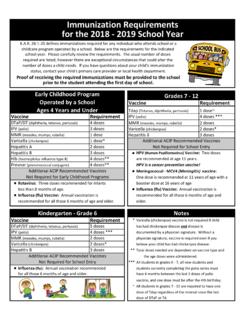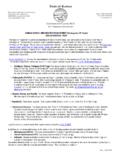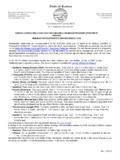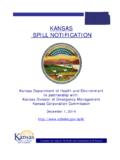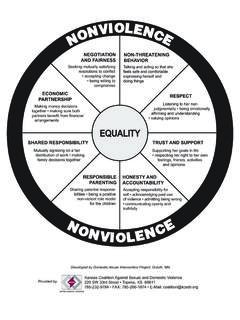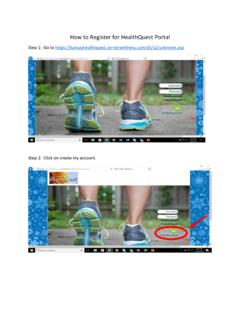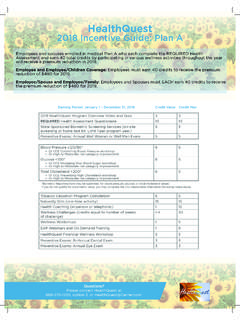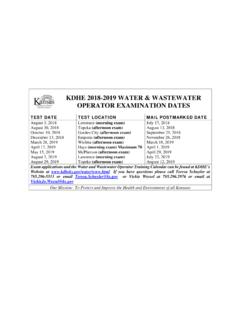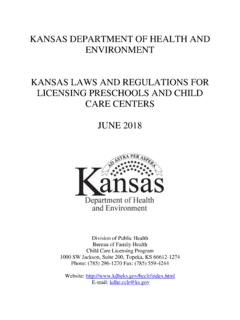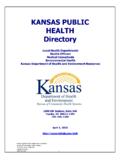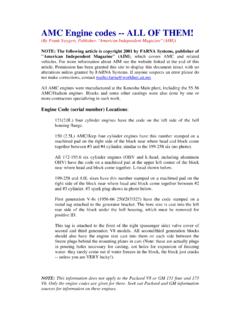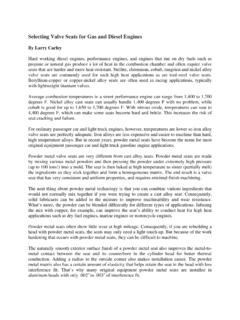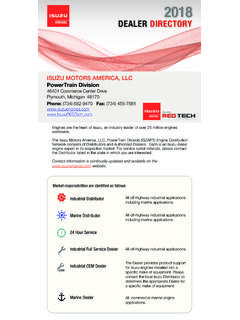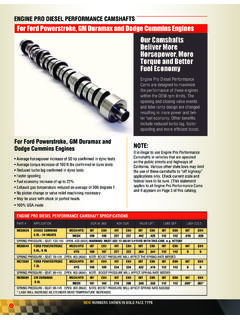Transcription of New Source Performance Standard (NSPS) for Owners ...
1 New Source Performance Standard (NSPS) for Owners /Operators of Stationary Compression Ignition Internal Combustion Engines in Kansas Rule overview In July 2006, the Environmental Protection Agency (EPA) finalized a rule in the Code of Federal Regulations (40 CFR Part 60 Subpart IIII) titled standards of Performance for Stationary Compression Ignition Internal Combustion Engines (CI ICE). This guidance document is designed to assist Kansas facilities in complying with this regulation. What is a stationary internal combustion engine ? A stationary internal combustion engine (ICE) is any ICE, except combustion turbines, that converts heat energy into mechanical work and is not mobile. Examples of engines that are NOT stationary are motor vehicles engines, garden tractors, lawn mowers, etc.
2 What is a compression ignition (CI) engine ? A CI engine is defined as a stationary ICE that is not a spark ignition engine . A spark ignition engine is defined as a gasoline, natural gas, or liquefied petroleum gas fueled engine or any other type of engine with a spark plug or sparking device. Refer to 40 CFR Part 60 Subpart JJJJ for standards of Performance for stationary spark ignition internal combustion engines. What is the intent of this rule? CI ICEs release several types of air pollutants into the environment including particulate matter (PM), nitrogen oxides (NOX), and carbon monoxide (CO). The pollutants from CI ICEs can greatly increase a facility s potential to emit (PTE). PTE is the maximum amount of air pollution your facility can emit if it operates at 100% capacity 24 hours/day, 365 days/year with no pollution control equipment in place.
3 Does this rule apply to my facility? [40 CFR Part ] You are subject to the rules of 40 CFR Part 60 Subpart IIII if you: Own/operate a stationary CI ICE that began construction after July 11, 2005 (date of construction is the date the engine was ordered by the owner or operator) and meets the following requirements: Manufactured after April 1, 2006 and not a fire pump engine Manufactured after July 1, 2006 as a certified National Fire Protection Association (NFPA) fire pump engine Own/operate a stationary CI ICE that was modified or reconstructed after July 11, 2005. You may be EXEMPT from this rule due to national security. A request for exemption must be submitted. Although not detailed in this guidance document, manufacturers of stationary CI ICEs that meet certain requirements are subject to this rule.
4 How long does this rule apply? [40 CFR Part ] This regulation applies to your facility for the duration of the useful life of the engine . If you are subject to this rule, there are several requirements you must meet, including compliance, reporting, recordkeeping, testing, fuel type, and installation deadlines. Deadlines to install CI ICEs [40 CFR Part ] Deadlines to install engines that were produced in previous model years depend on the size of the engine . The deadlines began in 2008 and continue to 2016. See the installation deadline table (Table 1) on page 3. Fuel requirements [40 CFR Part ] Owners and operators of stationary CI ICEs that are subject to this rule must meet the fuel requirements outlined in Table 2 on page 3. If you own/operate a pre-2011 model year stationary CI ICE, you may be able to petition for approval to use remaining non-compliant fuel.
5 Petitions should be sent to the EPA at the mailing address listed on page 2. National security exemptions may also be requested. Emission standards [40 CFR Parts and ] The emission standards your CI ICE must meet is greatly dependent on the model year, displacement of engine , and if it is an emergency and/or fire pump engine . standards for pre-2007 non-emergency and emergency engines that are not fire pumps are presented in Table 3 on page 3. For fire pumps, see Table 4 on page 4. Rule requirements 2 Emission standards (continued) Subpart IIII requires manufacturers of stationary CI ICEs to certify that engines beginning with model year 2007 meet the emission limits outlined in this rule. Check with your manufacturer to make certain the engine you purchase is in compliance.
6 Your engine manufacturer should be able to provide you with documentation that the engine meets the applicable standards . Monitoring requirements [40 CFR Part ] A stationary CI ICE equipped with a diesel particulate filter that is used to comply with emission standards must be installed with a backpressure monitor that notifies the owner/operator when the high backpressure limit of the engine is approached. Emergency CI ICEs must install a non-resettable hour meter prior to startup. Compliance requirements [40 CFR Part ] Operate and maintain the engine according to manufacturer instructions. Only change those settings that are permitted by the manufacturer. You must comply with applicable emission limits in Tables 3 and 4 and be able to prove your engine meets those limits.
7 The simplest method is to keep records of engine manufacturer and control device data that indicates compliance with the standards . The other option to prove compliance (although much more complex and potentially costly and time-consuming) is to conduct a Performance test on the engine or have documentation of a Performance test done on a similar engine . Notification, reporting and recordkeeping requirements [40 CFR Part ] See Table 5a and 5b on page 4 to determine notification, reporting, and recordkeeping requirements. In addition to the notification and reporting requirements described in this rule, you might also be required to submit a construction permit application for an engine construction (installation or modification). This form can be found at A guidance document regarding these construction permits and approvals is located at Is my CI ICE an emergency engine ?
8 A stationary ICE whose operation is limited to emergency situations (and required testing and maintenance) is considered to be an emergency engine . Engines used to supply power to an electric grid or that supply power as part of a financial arrangement with another entity are not considered to be emergency engines. If you have an emergency generator, you should fill out a simplified application for approval. This form is available at When evaluating your need for an air construction approval or permit, you can assume the emergency generator operates 500 hours per year. Maintenance checks and readiness testing should be limited to 100 hours per year. If you want more detailed information please refer to 40 CFR Part 60 Subpart IIII or you can contact the Kansas Small Business Environmental Assistance Program (SBEAP) at 800-578-8898 or visit Rule requirements KDHE Bureau of Air 1000 SW Jackson, Suite 310 Topeka, KS 66612-1366 Phone: 785-296-1570 US EPA Region 7 - Air Permitting/Compliance Branch 901 N.
9 5th Street Kansas City, KS 66101 Phone: 913-551-7003 K-State Small Business Environmental Assistance Program 133 Ward Hall Manhattan, KS 66506-2508 Phone: 800-578-8898 If the displacement of your engine is 30 liters per cylinder or greater, several additional emission Standard and compliance requirements including Performance testing apply to you. Contact David Peter with KDHE at 785-296-1104 for assistance. Published November 2009 Contact Information \ Emergency Generators While every effort was made to accurately reflect the requirements of 40 CFR Part 60, Subpart IIII, if any conflicts appear in this guidance document, the federal and state regulations will take precedence. 3 Table 2: Fuel requirements for Owners /operators of stationary CI ICEs [40 CFR Parts , (a), (b)] engine type and fuel use Requirements Date the requirements begin CI ICEs using diesel fuel Sulfur content 500 ppm or less, minimum cetane index of 40 or a maximum aromatic content of 35% by volume.
10 October 1, 2007 CI ICEs using diesel fuel with a displacement less than 30 liters/cylinder Sulfur content is 15 ppm or less, minimum cetane index of 40 or a maximum aromatic content of 35% by volume. October 10, 2010 Table 3: Emission standards for stationary CI ICEs [40 CFR Parts , , (a)(1), 40 CFR Part 60 Subpart IIII Tables 1 and 2] Maximum engine power All Pre-2007 model year engines with a displacement <10 liters/cylinder and 2007 2010 model year engines >3,000 HP (>2,237 kW) and with a displacement of <10 liters/cylinder Units: grams/HP-hr (grams/KW-hr) NMHC + NOX HC NOX CO PM HP<11 (kW<8) ( ) - - ( ) ( ) 11 HP<25 (8 kW<19) ( ) - ( ) ( ) - 25 HP<50 (19 kW<37) ( ) - ( ) ( ) - 50 HP<175 (37 kW<130) - - ( ) - - HP 175 (kW 130) - ( ) ( ) ( ) ( ) Maximum test speed Pre-2007 model year CI ICEs with displacement 10 L/cyl and <30 L/cyl Units.
